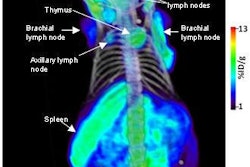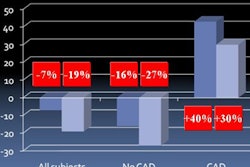NEW ORLEANS - The potential for nuclear medicine and molecular imaging to positively affect healthcare on a number of new frontiers in the next 20 years is substantial, but proponents face numerous challenges to make those goals a reality.
That message was delivered Sunday by Dr. Richard Wahl, director of nuclear medicine in the radiology department at Johns Hopkins Medical Institutions in Baltimore, at the opening of the 2008 SNM annual meeting.
Addressing the future of nuclear medicine and personalized therapies, Wahl said that when treating cancer, for example, "current treatments often are for the average patient and not tailored for the individual patient. Individualization of dose can hopefully, if done properly, maximize response and minimize toxicity."
The advance of instrumentation and software can take a prominent role in propelling near-term opportunities. "Clearly, in the next 20 years, I think our techniques will increase toward natural metabolic or natural molecular imaging, where we will view functional images in a metabolic context," Wahl said. Those applications can be accomplished with PET, SPECT, PET/CT, and MR spectroscopy and PET.
Obesity epidemic
One of the most critical issues in the next two decades will be the epidemic of obesity and diabetes. Wahl believes nuclear medicine will play a key role in imaging the diabetic foot, for example, through PET, with CT imaging for infection.
In the coming years, improved instrumentation will result in better image resolution and enhanced use of information to reconstruct images for quantitative analysis. "Automated analysis of complex studies will be increasingly important," Wahl said. "As anybody who reads PET/CT scans knows and tries to figure out responsive therapies knows, it can be very difficult and time-consuming. So, increasingly using our artificial intelligence approaches to make complex processes more simply assessed will be important."
But limitations and challenges in the coming years will influence the advance of nuclear medicine and molecular imaging. Among the issues is funding, or lack thereof, from the National Institutes of Health and the U.S. Department of Energy. Interactions with foundations and other agencies are critical to ensure that nuclear medicine and molecular imaging grow "at an appropriate rate relative to our needs and opportunities," Wahl added.
Disruptive technologies
Wahl believes that a proportion of the money spent in imaging and nuclear medicine and radiology research should be linked to the size of the imaging budget in the country. If that were so, budget allotments would be greater and adjust to the scale of demand.
A potential barrier that goes beyond FDA clearance, reimbursement approvals by the Centers for Medicare and Medical Services (CMS), and physician acceptance is what Wahl described as "disruptive technologies." That is, burgeoning technologies that are beneficial for patients and society but may adversely affect the revenue stream for physicians and caregivers.
The disruptive technologies "might lose money for hospitals, for drug companies, or reduce the revenue stream for oncologists, breast biopsy surgeons, or radiologists," Wahl said. "If they are too disruptive and begin to lose money for any one of the groups, the technique, though effective, may not be deployable."
Nuclear medicine advocates also must realize that cost and value are two different issues. Citing the example of the imaging agents, Wahl said there is disagreement on whether the benefits justify the costs. The investment to develop and bring an imaging agent to market is "a couple hundred million dollars," he estimated, and can take eight to 10 years to receive clearance for clinical use. "This is going to limit our access to new imaging agents because of the actualities of the business world. One of the issues is: Will the payment be sufficient?"
Wahl urged his SNM colleagues to develop high-quality cost data "to justify our approaches and justify their value."
By Wayne Forrest
AuntMinnie.com staff writer
June 15, 2008
Related Reading
SNM explores feasibility of U.S. medical isotope source, May 22, 2008
Canadian government to stop development of Maple reactors, May 16, 2008
New U.S. budget funds nuclear medicine programs, January 14, 2008
Medical imaging averts cuts in new U.S. budget, December 20, 2007
Report calls for more NM research funding, September 21, 2007
Copyright © 2008 AuntMinnie.com




















